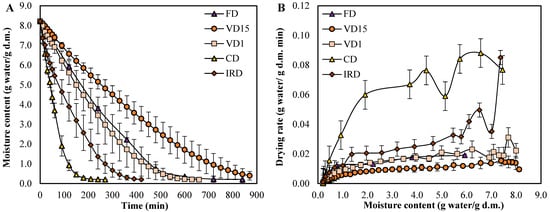The change in vegetable color during drying results from a combination of thermal effects, isomerization, oxidation, and enzymatic browning. In the case of carrots, this change is closely linked to their carotenoid content [54]. In this study, the changes in appearance of carrot waste after drying by different methods are shown in Table 3.
The CIELab values for fresh carrot waste were 49.10, 37.68, 48.63 units, for L*, a* and b* respectively, and these values specify the characteristic orange color of fresh carrots. These values are consistent with literature data [6,20,21,23].
After the drying processes, the L* parameter of the dehydrated samples increased considerably compared to the fresh sample (p ≤ 0.05), with 73.57, 61.62, 62.96, 65.98, and 70.40 units for FD, VD15, VD1, CD, and IRD treatments, respectively. These results are in accordance with Keser et al. [6], who also reported an increase in luminosity after the drying treatment of carrots. The concordance of results can be accredited to the fact that the dehydrated products have much less water and therefore the light is reflected differently [55]. All drying methods produced a decrease in a* and b* parameters in comparison to the fresh sample, indicating a decrease in redness and yellowness of the dried carrot waste. The losses in redness and yellowness of carrot can be strongly related to the decomposition of their carotenoids, flavonols, flavones, and isoflavones [22]. In particular, the IRD treatment showed the lowest a* and b* values among all samples (p < 0.05), which can be explained by the fact that exposure to radiant light exposure promotes the isomerization of carotenoids and their degradation [2]. The difference in ΔE* values of dried carrot waste was significant (p < 0.05), ranging from 15.55 to 34.39. This indicates that the drying process caused a visible color difference compared to fresh waste, as a ΔE* value greater than 3.5, according to the International Commission on Illumination (CIE), signifies a noticeable color change [56]. Among the dried samples, both IRD and FD presented the highest ΔE*. This is explained by the increase in L* and the reduction of b* and C*ab, meaning a lighter overall color and less vibrant orange. In fact, the higher h°ab and lower C*ab values in the IRD- and FD-dried samples confirmed that they turned more yellowish, while the VD15-dried carrot exhibited a more vivid orange character compared to the other dried samples. Although the VD15 sample has the lowest amount of carotenoids (Figure 4A), other pigments in carrots may have been enhanced by this drying method.
Source link
Antonio Vega-Galvez www.mdpi.com



